Background
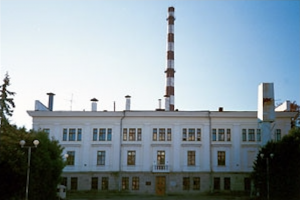
Obninsk nuclear power plant outside of Moscow. Photo credit: P. Pavlicek From Obninsk Beyond: Nuclear Power Conference Looks to Future” 2004).
After World War II (WWII), nuclear power development was progressing at high speed in the Soviet Union (USSR), and nuclear reactors were installed throughout the Eastern Bloc to provide electricity for industrialization. In 1954, the Obninsk nuclear reactor, located south of Moscow, opened and became the first nuclear reactor in the world “to produce electricity for a national grid” (Josephson 2005, 2). Because the Obninsk reactor represented a technological triumph for the USSR, it was a great source of pride and the rapid installation of many other nuclear reactors throughout the USSR soon followed.
The Chernobyl power plant, located in Pripyat, Ukraine, was intended to have ten RBMK nuclear reactors, which would power all of Ukraine (Josephson 2005, 2). But even by April 1986, when only four of the ten planned reactors were operating, Chernobyl was a 4,000 megawatt plant—the largest Ukraine (Marples 1987, 325). Between 1977 and 1983, the first four reactors were built at the Chernobyl nuclear plant, but the nuclear power development was progressing at a rapid pace in the post-war USSR. As a result, much of the labor force responsible for building and operating the plant was “undertrained” and “underqualified” for the job (Marples 1987, 326).
By April 1986, the first four reactors at Chernobyl were fully operative and reactors five and six were under construction (Josephson 2005, 6). Due to labor shortages at other nuclear plants, employees “who had acquired experience” working on reactors one and two has been transferred to other nuclear plants in Ukraine. Additionally, those who operated the Chernobyl plant frequently had to make due with “defective equipment, shortages of supplies and sudden changes in planning” (Marples 1987, 325). Together with “a deep-seated belief […] in the perfectibility of [Soviet] technology,” these realities left the largest nuclear power plant in Ukraine vulnerable to catastrophe (Josephson 2005).
The following video gives an overview of how nuclear reactors produce electricity and is helpful for understanding what went wrong at Chernobyl.
Chronology
On April 25, 1986, a routine test began on reactor No. 4 at the Chernobyl nuclear power plant. The purpose of the test was to check that reactor No. 4 could provide enough energy to turn on emergency generators in the event of a loss in power (Schmid et al. 2015, 127). Under normal conditions, the diesel-powered, emergency generators were designed provide electricity to the cooling pumps 20-30 seconds after a loss of power. Soviet leaders wanted to reduce this 20-30 second delay by harnessing electricity generated by the reactor’s turbine as it continued to move after power loss. Therefore, the experimental plan was to reduce the reactor’s power capacity, route all of the steam to a single turbine, and to use electricity generated by that turbine to power the plant before the emergency generators started (Marples 1987, 325).
By 1 pm on April 25, 1986, reactor No. 4’s power had been decreased to 50% of capacity, but at this point, operators were forced to pause the test. Chernobyl was supplying power to the Hungarian grid, and there was a high demand for electricity (Marples 1987, 325). Therefore, the plant operators were ordered to wait until 11:25 to resume the test (Schmid et al. 2015, 128).
The test resumed the night of April 25th at approximately 11 pm, but technical difficulties led the plant operators to reset the automatic reactor control system. After reset, the system unexpectedly responded by dropping power down to 1% of capacity, which was much lower than the 25-30% capacity power target (Filburn 2016, 61-62). Critically, an operator had shut-down the reactor’s automatic emergency shutdown and cooling systems because he was worried that the emergency shutdown system might stop the test (Marples 1987, 325).
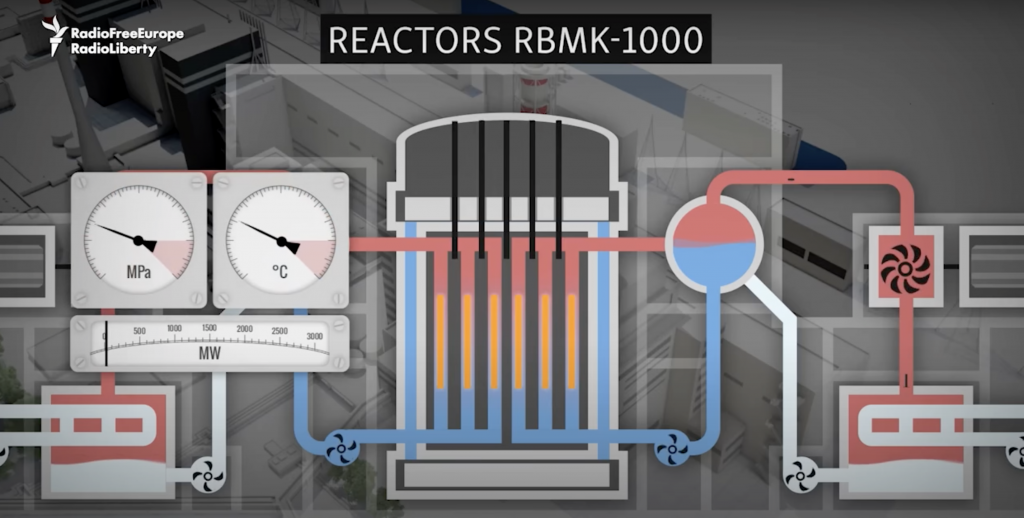
Diagram of a RBMK-1000 reactor. CLICK the image for an animation and explanation of Reactor No. 4’s meltdown.
By 12:30 am on April 26th, the operators had managed to increase the reactors power and began final preparations for the test. At 1:23 am, the test began when the steam valve closed to the turbine that had been powering four out of eight of the reactor’s coolant pumps. The steam build-up rapidly boiled water in the reactor, which decreased the available coolant and increased the number of neutrons in the reactor core. Operators attempted to start an emergency shutdown. But when graphite tips of the reactors control rods reached the reactor’s core, the addition of graphite to the already overpowered core resulted in a steam explosion that destroyed Reactor No. 4 (Filburn 2016, 62-63).
Reactor No. 4’s explosion released approximately 7 tons of radioactive debris into the air, caused the reactor to ignite in flames. Firefighters arrived and were able to put out the fire by 5 am (Marples 1987, 326). But the radioactive materials released into the atmosphere spread across northern and central Europe. Scandinavian countries recorded abnormally high radiation levels in the following days, but the most severely affected regions were Russia, Belarus, and Ukraine.
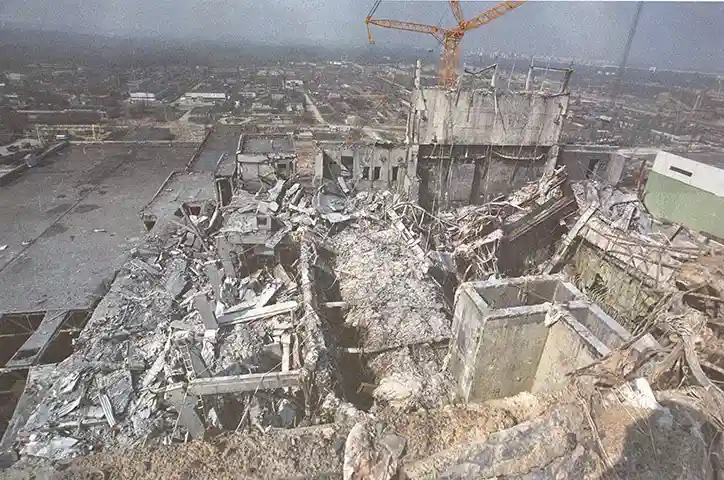
Destroyed Reactor No. 4 photographed by Igor Kostin in June 1986 (“From Obninsk Beyond: Nuclear Power Conference Looks to Future” 2004).
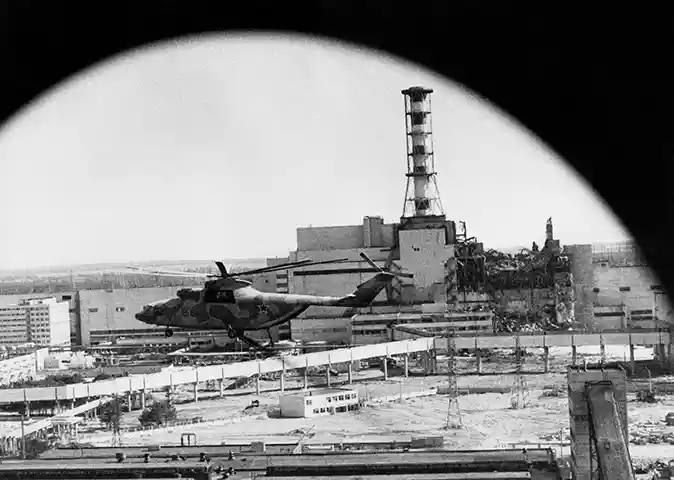
Helicopter dropping decontamination agents with destroyed Reactor No. 4 in the background. Photograph by Igor Kostin taken May 1986 (Chernobyl nuclear disaster – in pictures 2011).
Recovery
Immediately following the explosion, two Chernobyl employees were killed from burns and falling debris. Firefighters from the plant itself and Pripyat, the closest town, responded to the fires, and 26 first responders died within a few weeks due to exposure to high levels of radiation at the plant and/or treating the injured (Filburn 2016, 63-64). Firefighters were illy prepared to fight the large fire, but the managed to get the fire under control relatively quickly without allowing it to spread to any of the other reactors (Schmid et al. 2015, 134).
When Chernobyl’s reactor No. 4 exploded, 50,000 people lived in the nearby town, Pripyat, which had been built, so Chernobyl employees would have a place to live. Although there was an emergency plan that stated Pripyat citizens should have been ordered to stay inside and avoid radiation exposure, the Ministry of Internal Affairs failed to give shelter in place orders. There was much debate about potential evacuations. Therefore, Pripyat residents were not ordered to evacuate until 11 am on April 27 after 33 hours of exposure to significant radiation. At this point a 30 km exclusion zone was put in place surrounding Chernobyl and 135,000 people were evacuated (Schmid et al. 2015, 134). In the following days, additional areas were evacuated, and eventually 200,000 people living in the region were moved away (Filburn 2016).
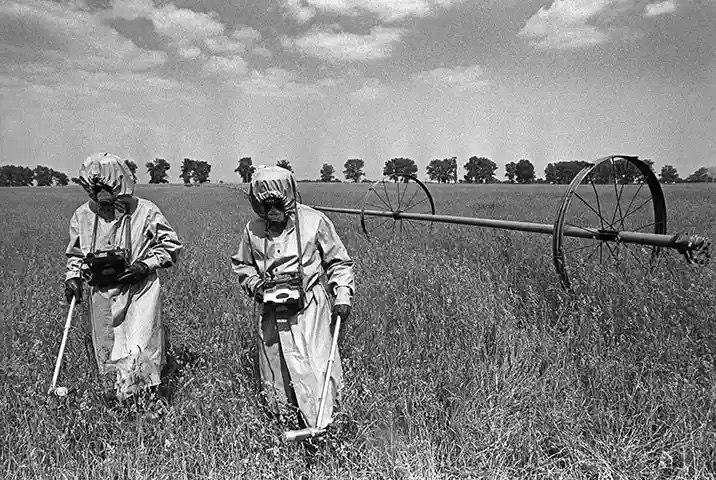
Liquidators measure radiation levels in the 30 km Chernobyl exclusion zone. Photograph taken by Igor Kostin in May 1986 (Chernobyl nuclear disaster – in pictures 2011).
The initial cleanup response lasted until 1988, and 30,000 people were involved in the cleanup. To stabilize the reactor core, helicopters dropped 5,000 tons of “neutron-absorbing material” during 1,800 different flights (Schmid et al. 2015, 135). The extreme radiation levels caused robots to malfunction. As a result, human laborers were drafted to clean-up debris at Chernobyl and to build a concrete sarcophagus to contain reactor No. 4 (Schmid et al. 2015, 136). These laborers were called “liquidators.” Initially, civilian volunteers served as liquidators, but laborers could only work for a limited time period due to the high levels of radiation, and eventually military reserves were used to fill the constant need to more liquidators (Marples 1987, 327).

Liquidators outfit themselves in lead aprons to protect against radiation. Photo taken by Igor Kostin (Chernobyl nuclear disaster – in pictures 2011).
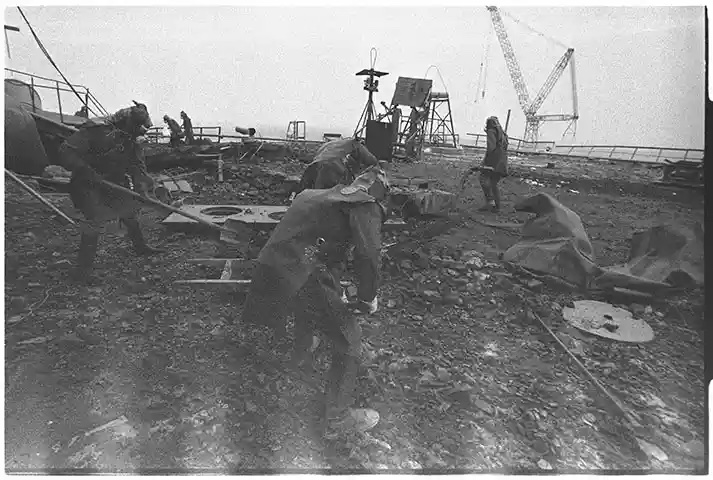
Liquidators remove radioactive debris from the roots of reactor No. 3. Photo by Igor Kostin taken September 1986 (Chernobyl nuclear disaster – in pictures 2011).
Amazingly, the sarcophagus structure was completed by November 1986, but it was hastily built and designed to last only 20-30 years. Because a collapse or breach of the sarcophagus would have resulted in a significant release of radiation, the European Union (EU) commissioned the construction of a new “Safe Confinement” structure to cover the sarcophagus and reactor No. 4. After the collapse of the USSR, the EU aimed to support independent Ukraine in managing the Chernobyl site (Filburn 2016, 65). The New Safe Confinement structure was completed in 2016 and was designed to last 100 years (“Chernobyl Shelter and Confinement, Ukraine”).
Sliding the safe confinement structure over Chernobyl in 2016:
Construction of the Safe Confinement structure:
